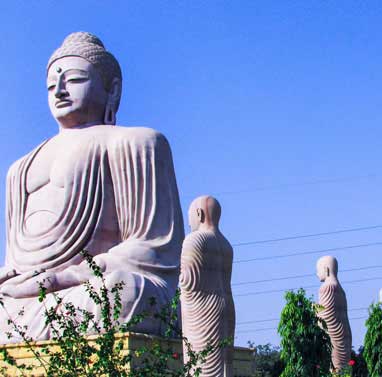Best of India Tours
- Golden Triangle Tour- Best of India & Nepal
- Classical Rajasthan
India Cultural Tours
- Images of North India- Karnataka Heritage
- Rajasthan & Goa Tour
Discover India Tours
- Grand India Tour- North to South India
- Central to South India
Rajasthan Tours
- Classical Rajasthan Tour- Golden Triangle Tour
- Grand Mughal Tour
India Luxury Trains
- Palace on Wheels- The Golden Chariot
- India Deccan Odyssey
- The Indian Maharaja
- Royal Rajasthan on Wheels
Nepal Tours
- Glimpses of Nepal- Buddhist Pilgrimage
- Nepal River Rafting
- Destinations of Nepal
- Nepal General Info
India Wildlife Tours
- North India Wild Life- South India Wildlife
Tibet Tours
- Tibet Monastery Tours- Explore Tibet
- Destinations of Tibet
Spa & Yoga Tours
- Ananda in Himalayas- Yoga & Meditation
Adventure Tours
- Manali Safari Tour- Himalayan Trekking
- Horse Safari
Gaya

A place of religious sanctity for Hindus, Gaya lies 12 kms from Bodhgaya between Pretshila and Ramshila hills and is washed by the shores of river Phalgu. Gaya has a large number of Buddhist temples also. While Buddha was doing severe penance, he became weak, tired and hungry. He rested under a tree where, he was offered food by a condemned village woman named Sujata. To everybody's surprise Buddha accepted her offerings. Legend has it, that after having consumed the food, Buddha's countenance assumed a divine glow and herealised the Supreme Truth; that neither extreme self indulgence nor self mortification is ever required.
What is needed is to follow the Middle Path. Sujata Sthan or Durgeshwari Temple stands as a symbol commemorating this event. In the vicinity of Bodhgaya, there are several other places of tourist interest such as the Surya Temple at Deo, 20 kms from Gay a; the Sun God Temple at Urnya; the Konchishwar Maha Deva temple at Konch; Barabar Caves just 40 kms away; the Buddhist Rock-Cut Caves of 3rd Century B.C. at Sasaram, 123 kms away.
As a pilgrimage centre, Gaya is second only to Varanasi, for Hindus believe whoever makes offerings here will free their ancestors from bondage to the earth. In Bodhgaya stands the descendant of the bo tree underwhich Lord Buddha attained enlightenment. Buddhist pilgrims from all over world come here throughout the year. The main temple is the Mahabodhi Temple, originally erected by Emperor Ashoka in the third century BC but restored only in 1882. Some Buddhist countries have built monasteries in this area in their nativestyles.
Click on the following links for Buddhist Pilgrimage Tours
-
At The Foot Steps of Buddha
Delhi - Jaipur - Agra - Varanasi - Bodhgaya - Patna - Kushinagar - Balrampur - Lumbini - Kathmandu
 Duration:(14 nights / 15 Days)
Duration:(14 nights / 15 Days) -
Buddhist Pilgrimage Tour (Nepal-India)
Delhi - Kathmandu - Lumbini - Sarasvati - Kushinagar - Patna - Bodhgaya - Varanasi - Agra - Jaipur - Delhi
 Duration:(15 nights / 16 Days)
Duration:(15 nights / 16 Days)




